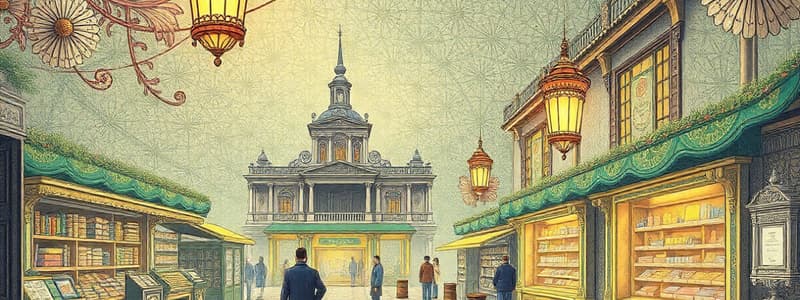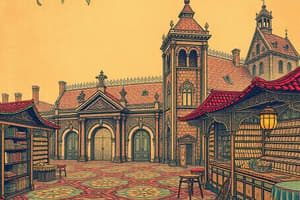Podcast
Questions and Answers
How does elasticity, as a concept in microeconomics, primarily influence business decisions?
How does elasticity, as a concept in microeconomics, primarily influence business decisions?
- By measuring the responsiveness of quantity demanded or supplied to changes in price or income, guiding pricing and production strategies. (correct)
- By providing a framework for understanding consumer preferences, enabling firms to tailor their advertising campaigns for maximum impact.
- By setting the regulatory standards for market competition, ensuring that no single firm can exert undue influence on pricing.
- By determining the fixed costs of production, allowing firms to optimize their scale of operations irrespective of market conditions.
In macroeconomics, what is the key distinction between fiscal policy and monetary policy in managing economic fluctuations?
In macroeconomics, what is the key distinction between fiscal policy and monetary policy in managing economic fluctuations?
- Fiscal policy is used to regulate international trade, while monetary policy is employed to stabilize domestic markets.
- Fiscal policy is managed by the central bank and involves adjusting interest rates, while monetary policy is controlled by the government through taxation.
- Fiscal policy focuses on long-term economic growth, while monetary policy addresses short-term inflationary pressures.
- Fiscal policy involves government spending and taxation to influence aggregate demand, while monetary policy involves managing interest rates and credit conditions. (correct)
Which economic theory posits that government intervention is crucial for stabilizing the economy, particularly during periods of recession?
Which economic theory posits that government intervention is crucial for stabilizing the economy, particularly during periods of recession?
- Classical economics
- Supply-side economics
- Monetarism
- Keynesian economics (correct)
How does an oligopolistic market structure typically differ from a perfectly competitive market?
How does an oligopolistic market structure typically differ from a perfectly competitive market?
What is the primary goal of a central bank when implementing monetary policies?
What is the primary goal of a central bank when implementing monetary policies?
Which of the following scenarios best illustrates the concept of market equilibrium?
Which of the following scenarios best illustrates the concept of market equilibrium?
How does behavioral economics challenge traditional economic assumptions about decision-making?
How does behavioral economics challenge traditional economic assumptions about decision-making?
What is the likely effect of a government implementing significant tax cuts, according to supply-side economics?
What is the likely effect of a government implementing significant tax cuts, according to supply-side economics?
Why might a government impose tariffs on imported goods?
Why might a government impose tariffs on imported goods?
Which scenario exemplifies monopolistic competition?
Which scenario exemplifies monopolistic competition?
Flashcards
Microeconomics
Microeconomics
Studies individual economic agents (households, firms) and their decisions on allocating scarce resources.
Macroeconomics
Macroeconomics
Studies the economy as a whole, focusing on aggregate variables like GDP, inflation, and unemployment.
Supply and Demand
Supply and Demand
The quantity of a product/service that is available and the desire of buyers for it.
Market Equilibrium
Market Equilibrium
Signup and view all the flashcards
Elasticity
Elasticity
Signup and view all the flashcards
Fiscal Policy
Fiscal Policy
Signup and view all the flashcards
Monetary Policy
Monetary Policy
Signup and view all the flashcards
Keynesian Economics
Keynesian Economics
Signup and view all the flashcards
Perfect Competition
Perfect Competition
Signup and view all the flashcards
Monopoly
Monopoly
Signup and view all the flashcards
Study Notes
- Economics is a social science that studies the production, distribution, and consumption of goods and services
- It analyzes how individuals, businesses, governments, and nations make choices on allocating resources to satisfy their wants and needs
Microeconomics
- Microeconomics focuses on the behavior of individual economic agents, such as households, firms, and markets
- It examines how these agents make decisions regarding the allocation of scarce resources
- Supply and demand are fundamental concepts, representing the quantity of a product or service that is available and the desire of buyers for it
- Market equilibrium occurs where the supply and demand curves intersect, determining the price and quantity at which transactions take place
- Elasticity measures the responsiveness of one variable to a change in another, such as the price elasticity of demand
- Consumer behavior is studied through utility theory, which examines how individuals make choices to maximize their satisfaction
- Production theory analyzes how firms make decisions about the quantity of goods or services to produce
- Cost theory examines the costs incurred by firms in the production process, including fixed, variable, and marginal costs
- Market structures, such as perfect competition, monopoly, oligopoly, and monopolistic competition, affect pricing and output decisions
Macroeconomics
- Macroeconomics studies the behavior of the economy as a whole
- It analyzes aggregate variables such as gross domestic product (GDP), inflation, and unemployment
- GDP measures the total value of goods and services produced within a country's borders during a specific period
- Inflation is the rate at which the general level of prices for goods and services is rising, and consequently, the purchasing power of currency is falling
- Unemployment refers to the number of people who are actively seeking employment but are unable to find a job
- Fiscal policy involves the use of government spending and taxation to influence the economy
- Monetary policy involves the use of interest rates and other tools to control the money supply and credit conditions
- Economic growth refers to the increase in the production of goods and services in an economy over time
- Business cycles are fluctuations in economic activity, characterized by periods of expansion and contraction
- International trade and finance examine the flow of goods, services, and capital between countries
Economic Theories
- Classical economics emphasizes the importance of free markets and limited government intervention
- It assumes that markets are self-regulating and that prices adjust to achieve equilibrium
- Keynesian economics argues that government intervention is necessary to stabilize the economy, particularly during recessions
- It emphasizes the role of aggregate demand in determining output and employment
- Monetarism focuses on the role of money supply in influencing economic activity
- It argues that controlling the money supply is the most effective way to stabilize the economy
- Supply-side economics emphasizes the importance of tax cuts and deregulation to stimulate economic growth
- It argues that these policies will increase the supply of goods and services, leading to lower prices and higher output
- Behavioral economics incorporates psychological insights into the study of economic decision-making
- It challenges the assumption that individuals are always rational and self-interested
Market Structures
- Perfect competition is characterized by a large number of buyers and sellers, homogeneous products, and free entry and exit
- No single firm has the power to influence the market price
- Monopoly is characterized by a single seller that controls the entire market
- The monopolist has the power to set the market price
- Oligopoly is characterized by a small number of firms that dominate the market
- Firms in an oligopoly are interdependent and their decisions affect each other
- Monopolistic competition is characterized by a large number of firms selling differentiated products
- Firms have some control over the price they charge
Economic Policies
- Fiscal policies involve the use of government spending and taxation to influence the economy
- Government spending can be used to stimulate demand during recessions or to provide public goods and services
- Taxation can be used to raise revenue for government spending or to discourage certain activities
- Monetary policies involve the use of interest rates and other tools to control the money supply and credit conditions
- Central banks can lower interest rates to stimulate borrowing and investment, or raise interest rates to combat inflation
- Trade policies involve the use of tariffs, quotas, and other measures to regulate international trade
- Tariffs are taxes on imports, while quotas are limits on the quantity of imports
- Regulatory policies involve the use of rules and regulations to govern economic activity
- Regulations can be used to protect consumers, workers, or the environment
Studying That Suits You
Use AI to generate personalized quizzes and flashcards to suit your learning preferences.




